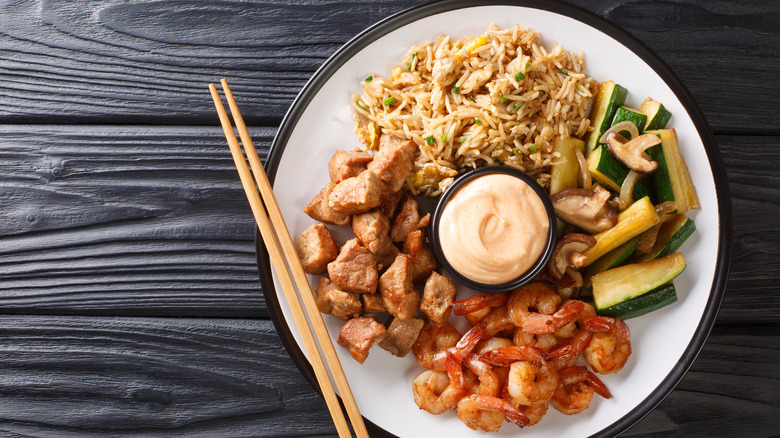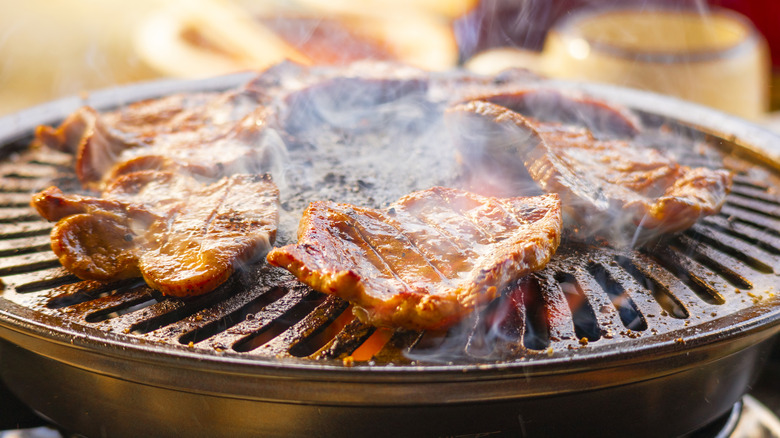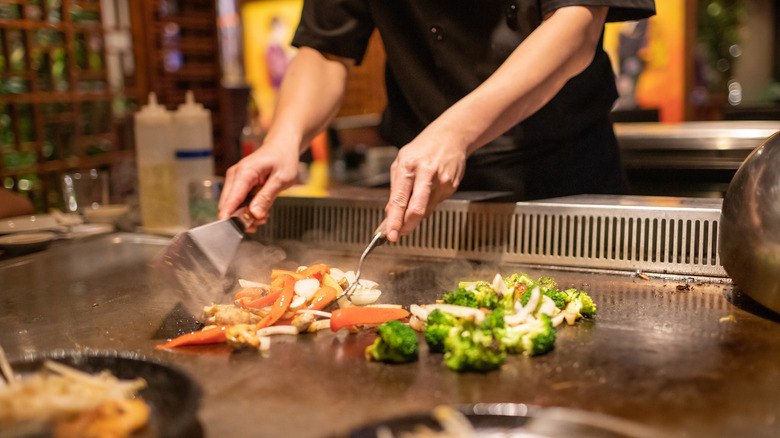The Key Difference Between Teppanyaki And Hibachi
Most Americans are familiar with Japanese steak houses. Even if you've never attended one personally, we have all seen footage in commercials or on TV of the large group tables built around a flat, steel grill with a chef standing in front of it, expertly slicing vegetables, flipping steaks, and catching discarded shrimp tails in their hat. It's a Japanese culinary tradition which has delighted customers with good food and showmanship for decades, yet as Americans, we're still not sure what to call it.
Japan has pioneered many unique culinary techniques throughout history, including two iconic grilling methods: Teppanyaki and Hibachi. However, many westerners tend to use the two terms interchangeably, or else completely confuse them for one another. While Japanese restaurant, Kobe Teppanyaki, notes that they do have their similarities – both are methods of cooking meat, seafood, and vegetables that utilize special grilling tools and both are often used in restaurants as a form of communal dining – the techniques and the tools used for them are incredibly different and may not mesh with what many Americans think of when they label their favorite Japanese cooking style.
Real hibachi
When most Americans think of "hibachi style" food they likely think of those large steel tables with the ultra-coordinated chefs showing off their fancy knife skills and sliding freshly cooked food directly onto guests' plates. This makes sense, since restaurant chains like Benihana, which made these dinner experiences in the U.S. mainstream in the 1960s, explicitly refer to their specialty dishes on their menus as "hibachi dinners."
Technically speaking though, this is a misnomer. According to Osaka Japanese Bistro in Las Vegas, a hibachi was a device originally invented in Japan around the year 800 and was used to heat rooms or water. It consisted of a large, metal-lined round bowl that was filled with charcoal or wood, like a portable fire pit. Eventually, people began to put metal grates over the fires so they could be used to cook, a technique sometimes known as shichirin, and even began building them into tables for convenience. While this aesthetic of cooking or having someone cook for you at the table is akin to what Americans call hibachi, the authentic style is actually much more similar to open-fire barbequing and is considered more casual.
It's actually teppanyaki
When you decide to go out for an entertaining date night at Benihana or a similar Japanese restaurant, what are you actually enjoying if not hibachi? The answer is teppanyaki. Although the exact origin date of this showy cooking style is not known, it is much newer than hibachi, and drew inspiration from it. No matter when it began, it became internationally popular after World War II, when American troops stationed in Japan began frequenting Tokyo restaurants and were enamored with the tastes and artful, fun presentation of the food (per Kimono Restaurants) Eventually, the popularity brought these teppanyaki style restaurants to the U.S., albeit under a somewhat confused name.
According to Bokksu, a Japanese food subscription box service, the actual word "teppanyaki" means "iron plate grilled" which highlights the primary difference between teppanyaki and hibachi. While hibachi literally refers to the open "fire bowl" that the grill grate is placed over, teppanyaki grilling involves cooking food on a hot, solid metal plate, which is usually built into the table to allow for the style's signature showmanship to be performed in front of guests. Another key difference is that these plates are usually heated with gas or propane, instead of an open coal or wood fire. This means the teppan grill's temperature is easier to control and they produce less potentially problematic smoke, which also makes them more suited to high-end restaurant experiences.


